Report on the Business Environment of Marks & Spencer: Analysis
VerifiedAdded on 2020/06/06
|12
|3823
|26
Report
AI Summary
This report provides a comprehensive analysis of Marks & Spencer's business environment. It begins by explaining different types of organizations (private, public, and voluntary) and their purposes, with Marks & Spencer used as an example of a private enterprise. The report then explores the size and scope of various organizations, including employee numbers and financial data, comparing Marks & Spencer to Secret Intelligence Service (MI6). A key section details the relationship between organizational functions (production, R&D, purchasing, HRM, accounting, and marketing) and how they link to the company's objectives and structure. The report also examines the positive and negative impacts of macro factors on Marks & Spencer using a PESTLE analysis (Political, Economic, Social, Technological, Legal, and Environmental). Finally, a SWOT analysis is presented to identify the company's Strengths, Weaknesses, Opportunities, and Threats, and how these interrelate with external macro factors. The report concludes with a summary of the key findings and provides references.

BUSINESS AND
BUSSINESS
ENVIRONMENT
1
BUSSINESS
ENVIRONMENT
1
Paraphrase This Document
Need a fresh take? Get an instant paraphrase of this document with our AI Paraphraser

2
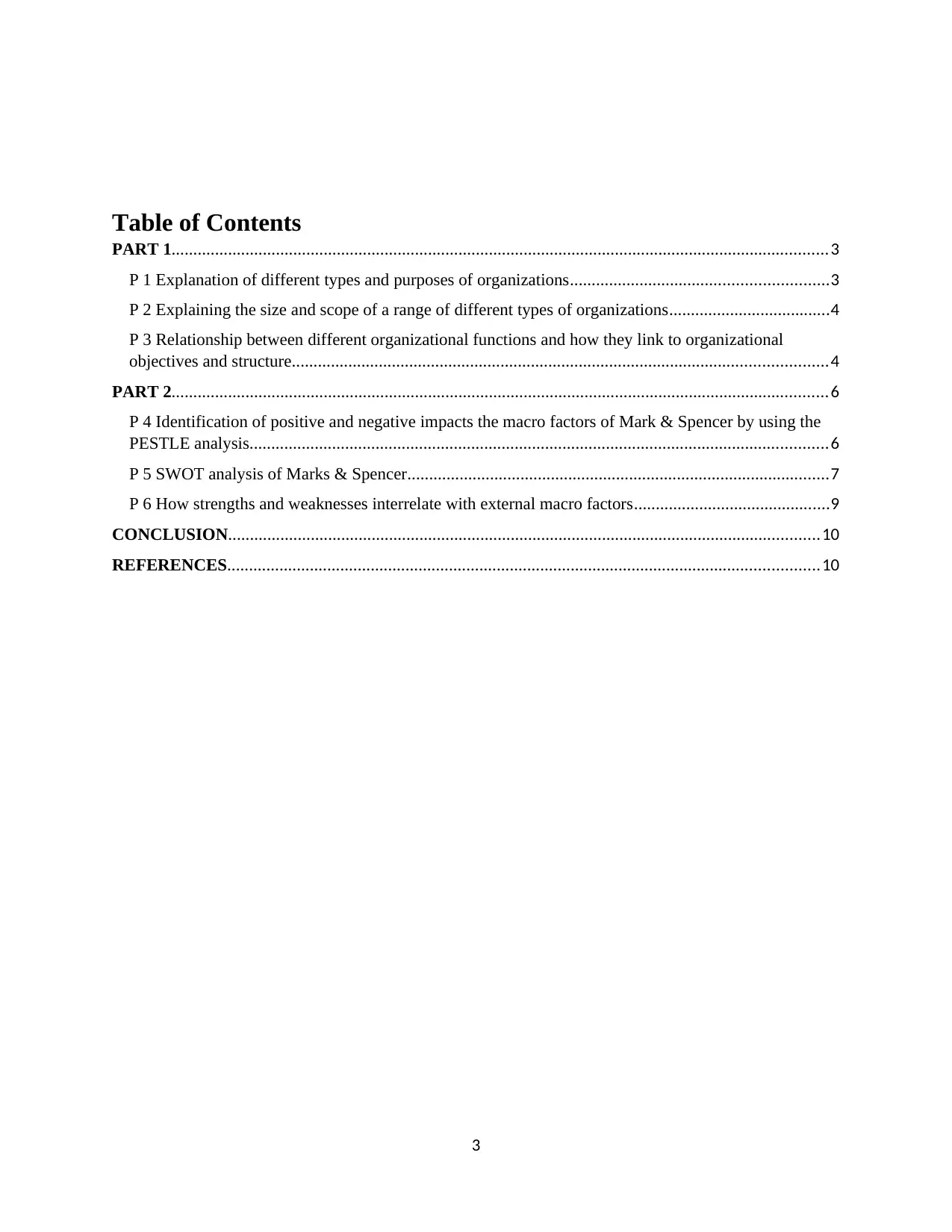
Table of Contents
PART 1.......................................................................................................................................................3
P 1 Explanation of different types and purposes of organizations...........................................................3
P 2 Explaining the size and scope of a range of different types of organizations.....................................4
P 3 Relationship between different organizational functions and how they link to organizational
objectives and structure...........................................................................................................................4
PART 2.......................................................................................................................................................6
P 4 Identification of positive and negative impacts the macro factors of Mark & Spencer by using the
PESTLE analysis.....................................................................................................................................6
P 5 SWOT analysis of Marks & Spencer.................................................................................................7
P 6 How strengths and weaknesses interrelate with external macro factors.............................................9
CONCLUSION........................................................................................................................................10
REFERENCES........................................................................................................................................10
3
PART 1.......................................................................................................................................................3
P 1 Explanation of different types and purposes of organizations...........................................................3
P 2 Explaining the size and scope of a range of different types of organizations.....................................4
P 3 Relationship between different organizational functions and how they link to organizational
objectives and structure...........................................................................................................................4
PART 2.......................................................................................................................................................6
P 4 Identification of positive and negative impacts the macro factors of Mark & Spencer by using the
PESTLE analysis.....................................................................................................................................6
P 5 SWOT analysis of Marks & Spencer.................................................................................................7
P 6 How strengths and weaknesses interrelate with external macro factors.............................................9
CONCLUSION........................................................................................................................................10
REFERENCES........................................................................................................................................10
3
⊘ This is a preview!⊘
Do you want full access?
Subscribe today to unlock all pages.

Trusted by 1+ million students worldwide

INTRODUCTION
Business environment can be simply defined as an environment where every organization
perform their business activities. It is the mixture of all internal and external factors. These
factors influence the execution of business of an enterprise (McClure, 2011). Such environment
creates its positive as well as negative impact on various parts of business like consumers,
workers and overall management. The present report is based on the business environment of
Marks & Spencer. In this project, three different organizations are explained that fall under
private, public and voluntary sector respectively. In addition to this, it also describes different
organizational functions and how they are associated with objectives and structure of
organization. Strength, Weaknesses, threats as well as opportunities is being discussed in this
report by using methods of SWOT analysis.
PART 1
P 1 Explanation of different types and purposes of organizations
There are three types of organizations namely private, public and voluntary. Private
enterprises are those which are owned by a single person or a group of people. They are
responsible for its funds and working. The main purpose of such type of corporations is to earn
large sum of profits and expand their business all around the world. Government does not play
any role in the functioning of such type of firms. Marks and Spencer fall under this type of
organization. This venture has more than 14000 stores available in all over the globe. They serve
people by their own branding food, clothes and home based products. On the other hand, public
sector ventures are owned as well as run by the government bodies. Their funding and each
requirement are fulfilled only by legal authorities. The major purpose of this type of company is
to provide goods and services at very low price to the civilians present in the nation. They are not
interesting in expanding their business or earning more and more profits. Secret Intelligence
Service (MI6) can be the best example of such type of firms. It is foreign intelligence service
provide by the UK government. Its main task is mainly associated with covert overseas
collection and analysis of human intelligence that supports national security of UK.
And the last but not the least, Voluntary organizations are those firms that are neither
owned by an individual nor by government bodies. They are isolated enterprises that are owned
by group of persons. Such type of ventures is having the purpose of serving the civilians of the
country. They are like nongovernmental organization (NGO). They also do not want to earn
profits but have the motive to serve common people. National Trust can be the best example of
this type of firm.
4
Business environment can be simply defined as an environment where every organization
perform their business activities. It is the mixture of all internal and external factors. These
factors influence the execution of business of an enterprise (McClure, 2011). Such environment
creates its positive as well as negative impact on various parts of business like consumers,
workers and overall management. The present report is based on the business environment of
Marks & Spencer. In this project, three different organizations are explained that fall under
private, public and voluntary sector respectively. In addition to this, it also describes different
organizational functions and how they are associated with objectives and structure of
organization. Strength, Weaknesses, threats as well as opportunities is being discussed in this
report by using methods of SWOT analysis.
PART 1
P 1 Explanation of different types and purposes of organizations
There are three types of organizations namely private, public and voluntary. Private
enterprises are those which are owned by a single person or a group of people. They are
responsible for its funds and working. The main purpose of such type of corporations is to earn
large sum of profits and expand their business all around the world. Government does not play
any role in the functioning of such type of firms. Marks and Spencer fall under this type of
organization. This venture has more than 14000 stores available in all over the globe. They serve
people by their own branding food, clothes and home based products. On the other hand, public
sector ventures are owned as well as run by the government bodies. Their funding and each
requirement are fulfilled only by legal authorities. The major purpose of this type of company is
to provide goods and services at very low price to the civilians present in the nation. They are not
interesting in expanding their business or earning more and more profits. Secret Intelligence
Service (MI6) can be the best example of such type of firms. It is foreign intelligence service
provide by the UK government. Its main task is mainly associated with covert overseas
collection and analysis of human intelligence that supports national security of UK.
And the last but not the least, Voluntary organizations are those firms that are neither
owned by an individual nor by government bodies. They are isolated enterprises that are owned
by group of persons. Such type of ventures is having the purpose of serving the civilians of the
country. They are like nongovernmental organization (NGO). They also do not want to earn
profits but have the motive to serve common people. National Trust can be the best example of
this type of firm.
4
Paraphrase This Document
Need a fresh take? Get an instant paraphrase of this document with our AI Paraphraser
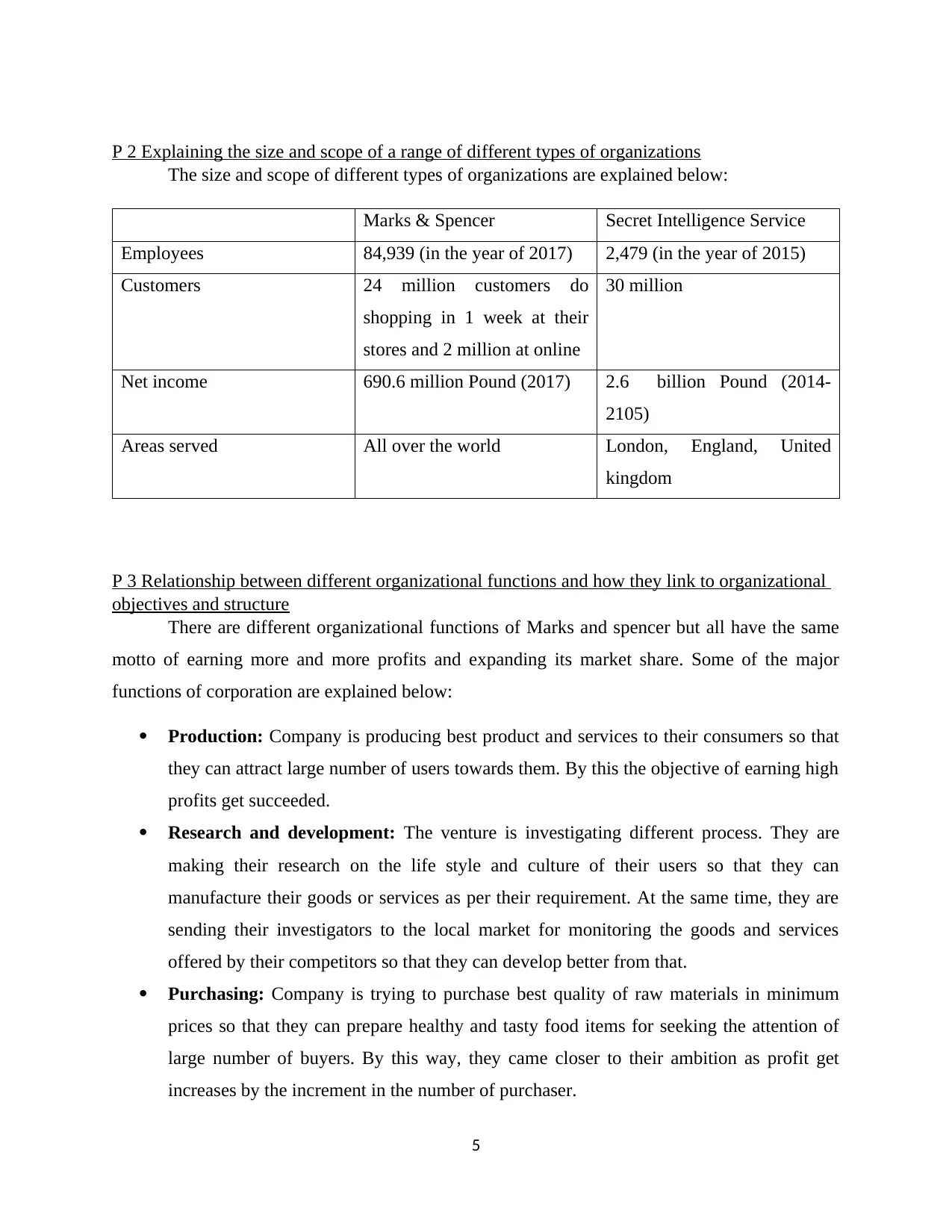
P 2 Explaining the size and scope of a range of different types of organizations
The size and scope of different types of organizations are explained below:
Marks & Spencer Secret Intelligence Service
Employees 84,939 (in the year of 2017) 2,479 (in the year of 2015)
Customers 24 million customers do
shopping in 1 week at their
stores and 2 million at online
30 million
Net income 690.6 million Pound (2017) 2.6 billion Pound (2014-
2105)
Areas served All over the world London, England, United
kingdom
P 3 Relationship between different organizational functions and how they link to organizational
objectives and structure
There are different organizational functions of Marks and spencer but all have the same
motto of earning more and more profits and expanding its market share. Some of the major
functions of corporation are explained below:
Production: Company is producing best product and services to their consumers so that
they can attract large number of users towards them. By this the objective of earning high
profits get succeeded.
Research and development: The venture is investigating different process. They are
making their research on the life style and culture of their users so that they can
manufacture their goods or services as per their requirement. At the same time, they are
sending their investigators to the local market for monitoring the goods and services
offered by their competitors so that they can develop better from that.
Purchasing: Company is trying to purchase best quality of raw materials in minimum
prices so that they can prepare healthy and tasty food items for seeking the attention of
large number of buyers. By this way, they came closer to their ambition as profit get
increases by the increment in the number of purchaser.
5
The size and scope of different types of organizations are explained below:
Marks & Spencer Secret Intelligence Service
Employees 84,939 (in the year of 2017) 2,479 (in the year of 2015)
Customers 24 million customers do
shopping in 1 week at their
stores and 2 million at online
30 million
Net income 690.6 million Pound (2017) 2.6 billion Pound (2014-
2105)
Areas served All over the world London, England, United
kingdom
P 3 Relationship between different organizational functions and how they link to organizational
objectives and structure
There are different organizational functions of Marks and spencer but all have the same
motto of earning more and more profits and expanding its market share. Some of the major
functions of corporation are explained below:
Production: Company is producing best product and services to their consumers so that
they can attract large number of users towards them. By this the objective of earning high
profits get succeeded.
Research and development: The venture is investigating different process. They are
making their research on the life style and culture of their users so that they can
manufacture their goods or services as per their requirement. At the same time, they are
sending their investigators to the local market for monitoring the goods and services
offered by their competitors so that they can develop better from that.
Purchasing: Company is trying to purchase best quality of raw materials in minimum
prices so that they can prepare healthy and tasty food items for seeking the attention of
large number of buyers. By this way, they came closer to their ambition as profit get
increases by the increment in the number of purchaser.
5
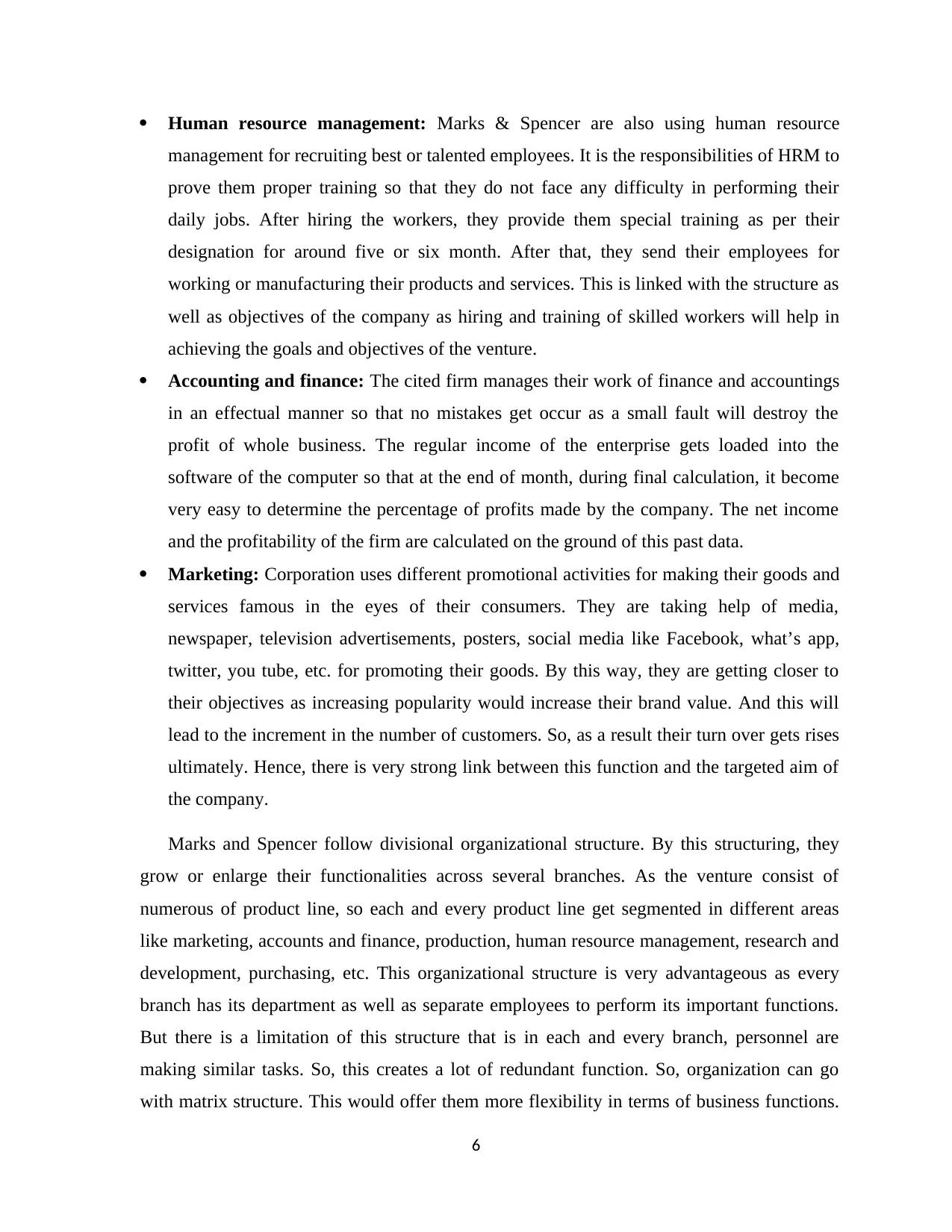
Human resource management: Marks & Spencer are also using human resource
management for recruiting best or talented employees. It is the responsibilities of HRM to
prove them proper training so that they do not face any difficulty in performing their
daily jobs. After hiring the workers, they provide them special training as per their
designation for around five or six month. After that, they send their employees for
working or manufacturing their products and services. This is linked with the structure as
well as objectives of the company as hiring and training of skilled workers will help in
achieving the goals and objectives of the venture.
Accounting and finance: The cited firm manages their work of finance and accountings
in an effectual manner so that no mistakes get occur as a small fault will destroy the
profit of whole business. The regular income of the enterprise gets loaded into the
software of the computer so that at the end of month, during final calculation, it become
very easy to determine the percentage of profits made by the company. The net income
and the profitability of the firm are calculated on the ground of this past data.
Marketing: Corporation uses different promotional activities for making their goods and
services famous in the eyes of their consumers. They are taking help of media,
newspaper, television advertisements, posters, social media like Facebook, what’s app,
twitter, you tube, etc. for promoting their goods. By this way, they are getting closer to
their objectives as increasing popularity would increase their brand value. And this will
lead to the increment in the number of customers. So, as a result their turn over gets rises
ultimately. Hence, there is very strong link between this function and the targeted aim of
the company.
Marks and Spencer follow divisional organizational structure. By this structuring, they
grow or enlarge their functionalities across several branches. As the venture consist of
numerous of product line, so each and every product line get segmented in different areas
like marketing, accounts and finance, production, human resource management, research and
development, purchasing, etc. This organizational structure is very advantageous as every
branch has its department as well as separate employees to perform its important functions.
But there is a limitation of this structure that is in each and every branch, personnel are
making similar tasks. So, this creates a lot of redundant function. So, organization can go
with matrix structure. This would offer them more flexibility in terms of business functions.
6
management for recruiting best or talented employees. It is the responsibilities of HRM to
prove them proper training so that they do not face any difficulty in performing their
daily jobs. After hiring the workers, they provide them special training as per their
designation for around five or six month. After that, they send their employees for
working or manufacturing their products and services. This is linked with the structure as
well as objectives of the company as hiring and training of skilled workers will help in
achieving the goals and objectives of the venture.
Accounting and finance: The cited firm manages their work of finance and accountings
in an effectual manner so that no mistakes get occur as a small fault will destroy the
profit of whole business. The regular income of the enterprise gets loaded into the
software of the computer so that at the end of month, during final calculation, it become
very easy to determine the percentage of profits made by the company. The net income
and the profitability of the firm are calculated on the ground of this past data.
Marketing: Corporation uses different promotional activities for making their goods and
services famous in the eyes of their consumers. They are taking help of media,
newspaper, television advertisements, posters, social media like Facebook, what’s app,
twitter, you tube, etc. for promoting their goods. By this way, they are getting closer to
their objectives as increasing popularity would increase their brand value. And this will
lead to the increment in the number of customers. So, as a result their turn over gets rises
ultimately. Hence, there is very strong link between this function and the targeted aim of
the company.
Marks and Spencer follow divisional organizational structure. By this structuring, they
grow or enlarge their functionalities across several branches. As the venture consist of
numerous of product line, so each and every product line get segmented in different areas
like marketing, accounts and finance, production, human resource management, research and
development, purchasing, etc. This organizational structure is very advantageous as every
branch has its department as well as separate employees to perform its important functions.
But there is a limitation of this structure that is in each and every branch, personnel are
making similar tasks. So, this creates a lot of redundant function. So, organization can go
with matrix structure. This would offer them more flexibility in terms of business functions.
6
⊘ This is a preview!⊘
Do you want full access?
Subscribe today to unlock all pages.

Trusted by 1+ million students worldwide

By adopting this structure, the workers present in firms can work in a function based sector
such as marketing and finance. Employee will work under different managers as different
tasks are allotted to them. This organizational structure can be changed as per the needs of
consumers. The only disadvantage of this would create a chain of matrix which become
cloudier and complexibility gets higher to handle this.
PART 2
P 4 Identification of positive and negative impacts the macro factors of Mark & Spencer by using
the PESTLE analysis
In the business environment, there are several risk associated with macro factors that are
increasing day on day but are difficult to find, for the company and the loaner. The mangers of
the business have to understand and consider the impact of macro factors on the business or its
markets. For controlling the risk, managements of business have to be aware of all the changes of
macro environments.
The impacts are of various macro factors on the Marks and Spencer are explained below:
Political factor: - In the business environment, company faces various political
problems. They are completely impacted by not only local government but also by the
foreign government. Corporation have to consider and follow all the government policies
and plans. Various norms made by government bodies such as imposition of high rate of
taxes (Saunders, 2014). This gives its negative impact on the turnover of company as
large amount of venture wastes only in paying such taxes. But there is also positive
impact of political factor. Government provides various types of funding or loans to the
company for its management.
Economical factor: - This is the major business problems at the time of development of
business as retailer sector of UK is quite recession prawn and act sensitively to the
alteration made in interest rate. After the financial crisis of 2009, people are saving their
revenues and due to that they are not using the luxurious facilities of the firm as they are
very costly. So, economic factor act negatively to the performance of venture. But if the
wages or salary of common people increases, they again try to purchase all kind of goods
of the company. By this way it can act as positive factor.
Social factor: -This may impact both positively as well as negatively on the business.
The customers which buy the products may change their mentality if they heard
something wrong about the quality of product if corporation offers best quality products
to them. But if they do not feel good by using their goods and services, then they do not
buy that product again and also tell their relatives or friend to not purchase that product
7
such as marketing and finance. Employee will work under different managers as different
tasks are allotted to them. This organizational structure can be changed as per the needs of
consumers. The only disadvantage of this would create a chain of matrix which become
cloudier and complexibility gets higher to handle this.
PART 2
P 4 Identification of positive and negative impacts the macro factors of Mark & Spencer by using
the PESTLE analysis
In the business environment, there are several risk associated with macro factors that are
increasing day on day but are difficult to find, for the company and the loaner. The mangers of
the business have to understand and consider the impact of macro factors on the business or its
markets. For controlling the risk, managements of business have to be aware of all the changes of
macro environments.
The impacts are of various macro factors on the Marks and Spencer are explained below:
Political factor: - In the business environment, company faces various political
problems. They are completely impacted by not only local government but also by the
foreign government. Corporation have to consider and follow all the government policies
and plans. Various norms made by government bodies such as imposition of high rate of
taxes (Saunders, 2014). This gives its negative impact on the turnover of company as
large amount of venture wastes only in paying such taxes. But there is also positive
impact of political factor. Government provides various types of funding or loans to the
company for its management.
Economical factor: - This is the major business problems at the time of development of
business as retailer sector of UK is quite recession prawn and act sensitively to the
alteration made in interest rate. After the financial crisis of 2009, people are saving their
revenues and due to that they are not using the luxurious facilities of the firm as they are
very costly. So, economic factor act negatively to the performance of venture. But if the
wages or salary of common people increases, they again try to purchase all kind of goods
of the company. By this way it can act as positive factor.
Social factor: -This may impact both positively as well as negatively on the business.
The customers which buy the products may change their mentality if they heard
something wrong about the quality of product if corporation offers best quality products
to them. But if they do not feel good by using their goods and services, then they do not
buy that product again and also tell their relatives or friend to not purchase that product
7
Paraphrase This Document
Need a fresh take? Get an instant paraphrase of this document with our AI Paraphraser
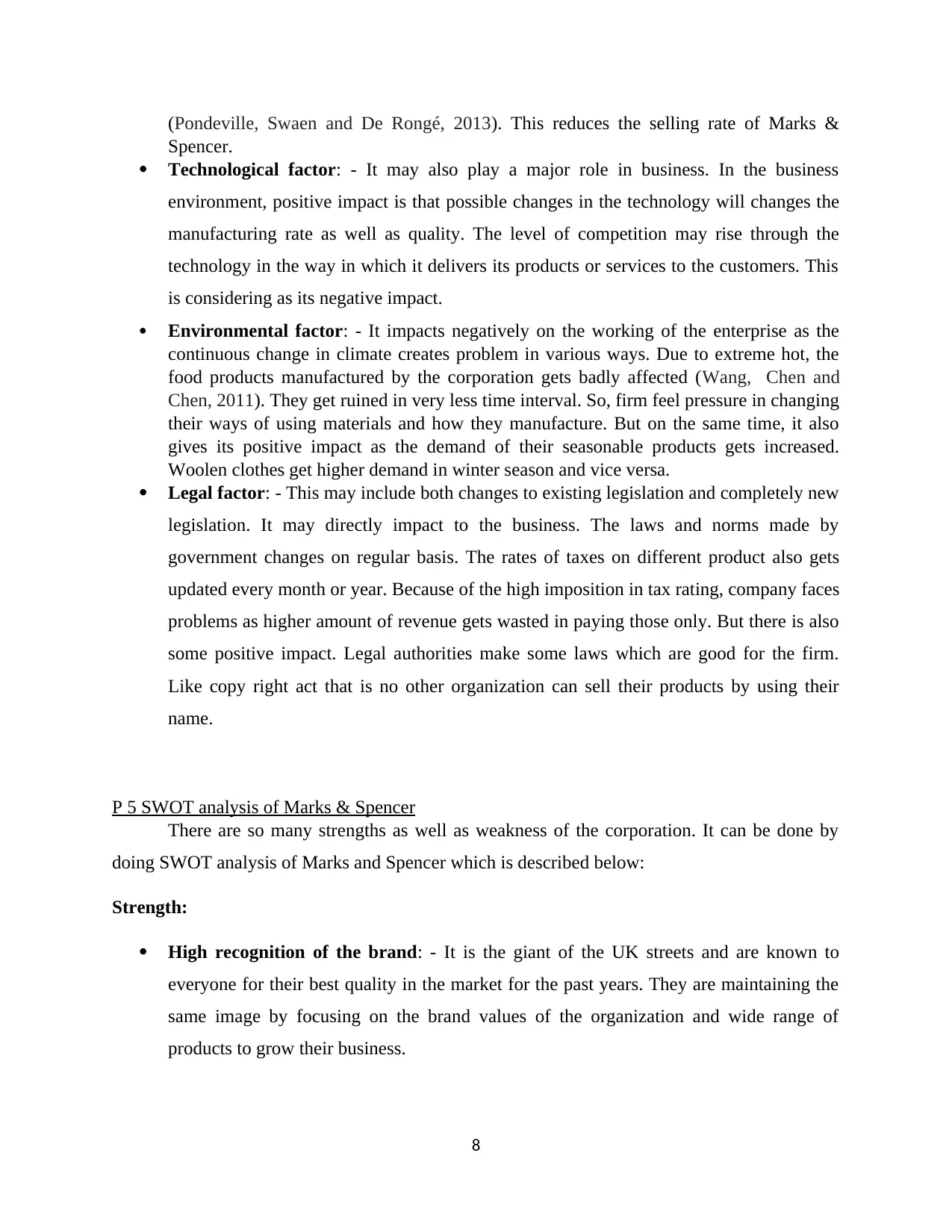
(Pondeville, Swaen and De Rongé, 2013). This reduces the selling rate of Marks &
Spencer.
Technological factor: - It may also play a major role in business. In the business
environment, positive impact is that possible changes in the technology will changes the
manufacturing rate as well as quality. The level of competition may rise through the
technology in the way in which it delivers its products or services to the customers. This
is considering as its negative impact.
Environmental factor: - It impacts negatively on the working of the enterprise as the
continuous change in climate creates problem in various ways. Due to extreme hot, the
food products manufactured by the corporation gets badly affected (Wang, Chen and
Chen, 2011). They get ruined in very less time interval. So, firm feel pressure in changing
their ways of using materials and how they manufacture. But on the same time, it also
gives its positive impact as the demand of their seasonable products gets increased.
Woolen clothes get higher demand in winter season and vice versa.
Legal factor: - This may include both changes to existing legislation and completely new
legislation. It may directly impact to the business. The laws and norms made by
government changes on regular basis. The rates of taxes on different product also gets
updated every month or year. Because of the high imposition in tax rating, company faces
problems as higher amount of revenue gets wasted in paying those only. But there is also
some positive impact. Legal authorities make some laws which are good for the firm.
Like copy right act that is no other organization can sell their products by using their
name.
P 5 SWOT analysis of Marks & Spencer
There are so many strengths as well as weakness of the corporation. It can be done by
doing SWOT analysis of Marks and Spencer which is described below:
Strength:
High recognition of the brand: - It is the giant of the UK streets and are known to
everyone for their best quality in the market for the past years. They are maintaining the
same image by focusing on the brand values of the organization and wide range of
products to grow their business.
8
Spencer.
Technological factor: - It may also play a major role in business. In the business
environment, positive impact is that possible changes in the technology will changes the
manufacturing rate as well as quality. The level of competition may rise through the
technology in the way in which it delivers its products or services to the customers. This
is considering as its negative impact.
Environmental factor: - It impacts negatively on the working of the enterprise as the
continuous change in climate creates problem in various ways. Due to extreme hot, the
food products manufactured by the corporation gets badly affected (Wang, Chen and
Chen, 2011). They get ruined in very less time interval. So, firm feel pressure in changing
their ways of using materials and how they manufacture. But on the same time, it also
gives its positive impact as the demand of their seasonable products gets increased.
Woolen clothes get higher demand in winter season and vice versa.
Legal factor: - This may include both changes to existing legislation and completely new
legislation. It may directly impact to the business. The laws and norms made by
government changes on regular basis. The rates of taxes on different product also gets
updated every month or year. Because of the high imposition in tax rating, company faces
problems as higher amount of revenue gets wasted in paying those only. But there is also
some positive impact. Legal authorities make some laws which are good for the firm.
Like copy right act that is no other organization can sell their products by using their
name.
P 5 SWOT analysis of Marks & Spencer
There are so many strengths as well as weakness of the corporation. It can be done by
doing SWOT analysis of Marks and Spencer which is described below:
Strength:
High recognition of the brand: - It is the giant of the UK streets and are known to
everyone for their best quality in the market for the past years. They are maintaining the
same image by focusing on the brand values of the organization and wide range of
products to grow their business.
8
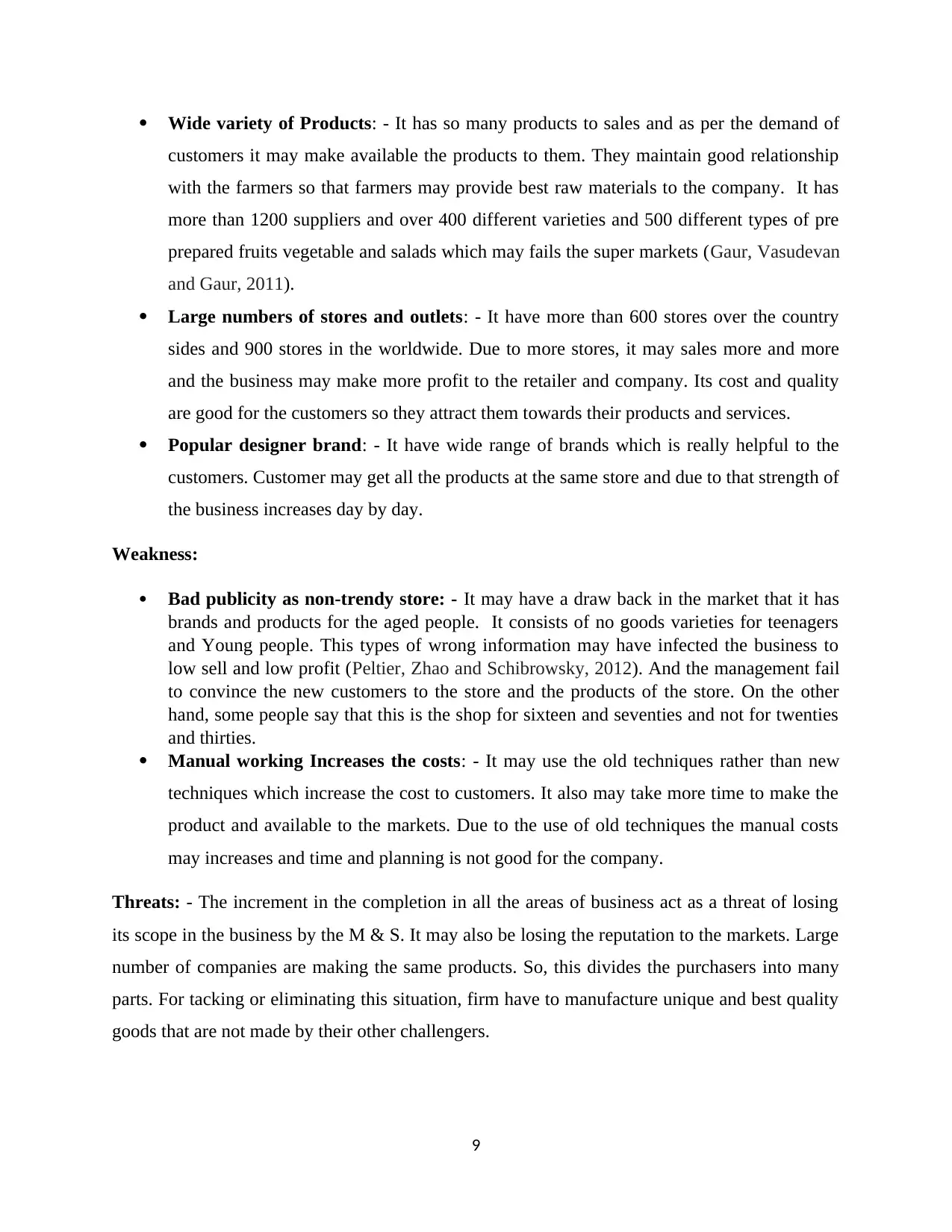
Wide variety of Products: - It has so many products to sales and as per the demand of
customers it may make available the products to them. They maintain good relationship
with the farmers so that farmers may provide best raw materials to the company. It has
more than 1200 suppliers and over 400 different varieties and 500 different types of pre
prepared fruits vegetable and salads which may fails the super markets (Gaur, Vasudevan
and Gaur, 2011).
Large numbers of stores and outlets: - It have more than 600 stores over the country
sides and 900 stores in the worldwide. Due to more stores, it may sales more and more
and the business may make more profit to the retailer and company. Its cost and quality
are good for the customers so they attract them towards their products and services.
Popular designer brand: - It have wide range of brands which is really helpful to the
customers. Customer may get all the products at the same store and due to that strength of
the business increases day by day.
Weakness:
Bad publicity as non-trendy store: - It may have a draw back in the market that it has
brands and products for the aged people. It consists of no goods varieties for teenagers
and Young people. This types of wrong information may have infected the business to
low sell and low profit (Peltier, Zhao and Schibrowsky, 2012). And the management fail
to convince the new customers to the store and the products of the store. On the other
hand, some people say that this is the shop for sixteen and seventies and not for twenties
and thirties.
Manual working Increases the costs: - It may use the old techniques rather than new
techniques which increase the cost to customers. It also may take more time to make the
product and available to the markets. Due to the use of old techniques the manual costs
may increases and time and planning is not good for the company.
Threats: - The increment in the completion in all the areas of business act as a threat of losing
its scope in the business by the M & S. It may also be losing the reputation to the markets. Large
number of companies are making the same products. So, this divides the purchasers into many
parts. For tacking or eliminating this situation, firm have to manufacture unique and best quality
goods that are not made by their other challengers.
9
customers it may make available the products to them. They maintain good relationship
with the farmers so that farmers may provide best raw materials to the company. It has
more than 1200 suppliers and over 400 different varieties and 500 different types of pre
prepared fruits vegetable and salads which may fails the super markets (Gaur, Vasudevan
and Gaur, 2011).
Large numbers of stores and outlets: - It have more than 600 stores over the country
sides and 900 stores in the worldwide. Due to more stores, it may sales more and more
and the business may make more profit to the retailer and company. Its cost and quality
are good for the customers so they attract them towards their products and services.
Popular designer brand: - It have wide range of brands which is really helpful to the
customers. Customer may get all the products at the same store and due to that strength of
the business increases day by day.
Weakness:
Bad publicity as non-trendy store: - It may have a draw back in the market that it has
brands and products for the aged people. It consists of no goods varieties for teenagers
and Young people. This types of wrong information may have infected the business to
low sell and low profit (Peltier, Zhao and Schibrowsky, 2012). And the management fail
to convince the new customers to the store and the products of the store. On the other
hand, some people say that this is the shop for sixteen and seventies and not for twenties
and thirties.
Manual working Increases the costs: - It may use the old techniques rather than new
techniques which increase the cost to customers. It also may take more time to make the
product and available to the markets. Due to the use of old techniques the manual costs
may increases and time and planning is not good for the company.
Threats: - The increment in the completion in all the areas of business act as a threat of losing
its scope in the business by the M & S. It may also be losing the reputation to the markets. Large
number of companies are making the same products. So, this divides the purchasers into many
parts. For tacking or eliminating this situation, firm have to manufacture unique and best quality
goods that are not made by their other challengers.
9
⊘ This is a preview!⊘
Do you want full access?
Subscribe today to unlock all pages.

Trusted by 1+ million students worldwide
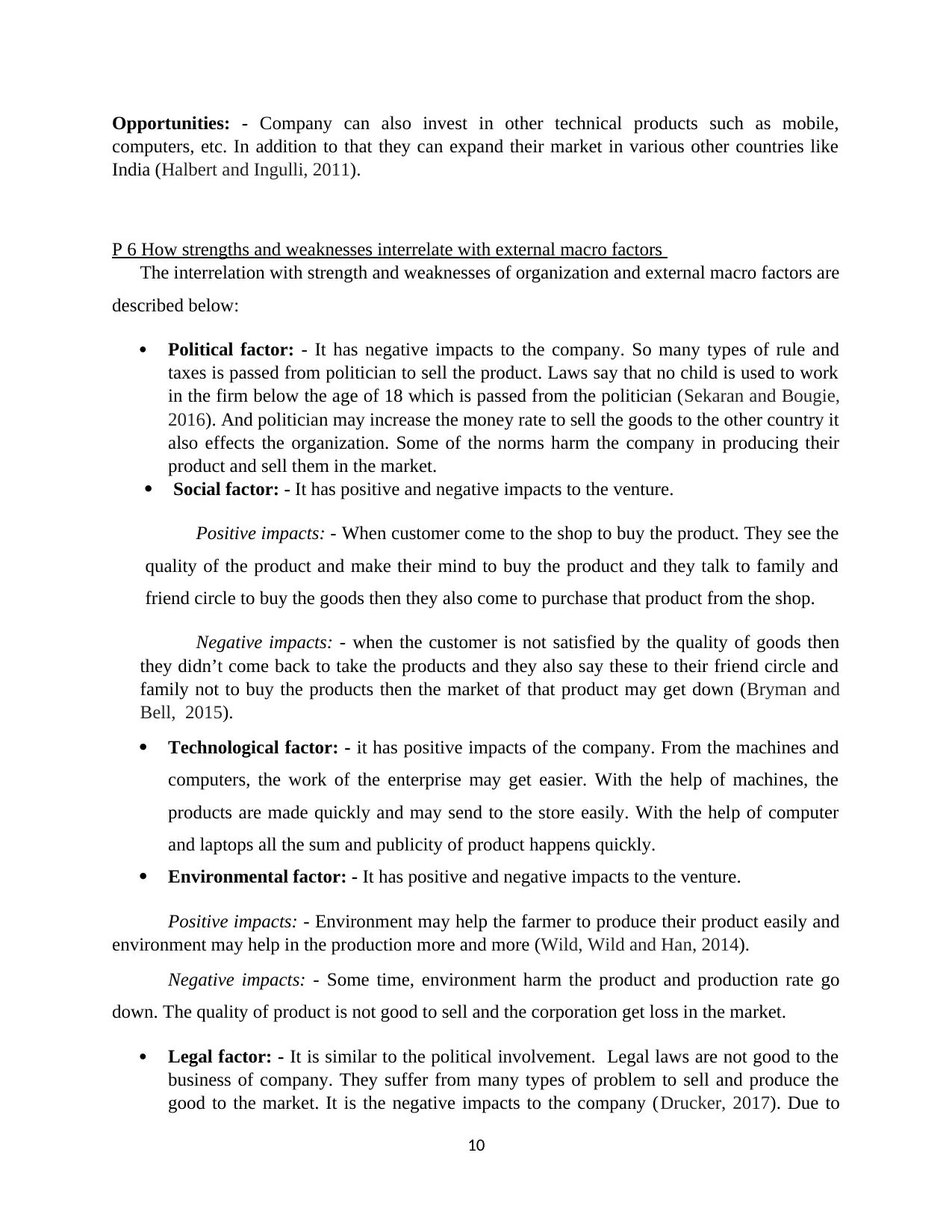
Opportunities: - Company can also invest in other technical products such as mobile,
computers, etc. In addition to that they can expand their market in various other countries like
India (Halbert and Ingulli, 2011).
P 6 How strengths and weaknesses interrelate with external macro factors
The interrelation with strength and weaknesses of organization and external macro factors are
described below:
Political factor: - It has negative impacts to the company. So many types of rule and
taxes is passed from politician to sell the product. Laws say that no child is used to work
in the firm below the age of 18 which is passed from the politician (Sekaran and Bougie,
2016). And politician may increase the money rate to sell the goods to the other country it
also effects the organization. Some of the norms harm the company in producing their
product and sell them in the market.
Social factor: - It has positive and negative impacts to the venture.
Positive impacts: - When customer come to the shop to buy the product. They see the
quality of the product and make their mind to buy the product and they talk to family and
friend circle to buy the goods then they also come to purchase that product from the shop.
Negative impacts: - when the customer is not satisfied by the quality of goods then
they didn’t come back to take the products and they also say these to their friend circle and
family not to buy the products then the market of that product may get down (Bryman and
Bell, 2015).
Technological factor: - it has positive impacts of the company. From the machines and
computers, the work of the enterprise may get easier. With the help of machines, the
products are made quickly and may send to the store easily. With the help of computer
and laptops all the sum and publicity of product happens quickly.
Environmental factor: - It has positive and negative impacts to the venture.
Positive impacts: - Environment may help the farmer to produce their product easily and
environment may help in the production more and more (Wild, Wild and Han, 2014).
Negative impacts: - Some time, environment harm the product and production rate go
down. The quality of product is not good to sell and the corporation get loss in the market.
Legal factor: - It is similar to the political involvement. Legal laws are not good to the
business of company. They suffer from many types of problem to sell and produce the
good to the market. It is the negative impacts to the company (Drucker, 2017). Due to
10
computers, etc. In addition to that they can expand their market in various other countries like
India (Halbert and Ingulli, 2011).
P 6 How strengths and weaknesses interrelate with external macro factors
The interrelation with strength and weaknesses of organization and external macro factors are
described below:
Political factor: - It has negative impacts to the company. So many types of rule and
taxes is passed from politician to sell the product. Laws say that no child is used to work
in the firm below the age of 18 which is passed from the politician (Sekaran and Bougie,
2016). And politician may increase the money rate to sell the goods to the other country it
also effects the organization. Some of the norms harm the company in producing their
product and sell them in the market.
Social factor: - It has positive and negative impacts to the venture.
Positive impacts: - When customer come to the shop to buy the product. They see the
quality of the product and make their mind to buy the product and they talk to family and
friend circle to buy the goods then they also come to purchase that product from the shop.
Negative impacts: - when the customer is not satisfied by the quality of goods then
they didn’t come back to take the products and they also say these to their friend circle and
family not to buy the products then the market of that product may get down (Bryman and
Bell, 2015).
Technological factor: - it has positive impacts of the company. From the machines and
computers, the work of the enterprise may get easier. With the help of machines, the
products are made quickly and may send to the store easily. With the help of computer
and laptops all the sum and publicity of product happens quickly.
Environmental factor: - It has positive and negative impacts to the venture.
Positive impacts: - Environment may help the farmer to produce their product easily and
environment may help in the production more and more (Wild, Wild and Han, 2014).
Negative impacts: - Some time, environment harm the product and production rate go
down. The quality of product is not good to sell and the corporation get loss in the market.
Legal factor: - It is similar to the political involvement. Legal laws are not good to the
business of company. They suffer from many types of problem to sell and produce the
good to the market. It is the negative impacts to the company (Drucker, 2017). Due to
10
Paraphrase This Document
Need a fresh take? Get an instant paraphrase of this document with our AI Paraphraser
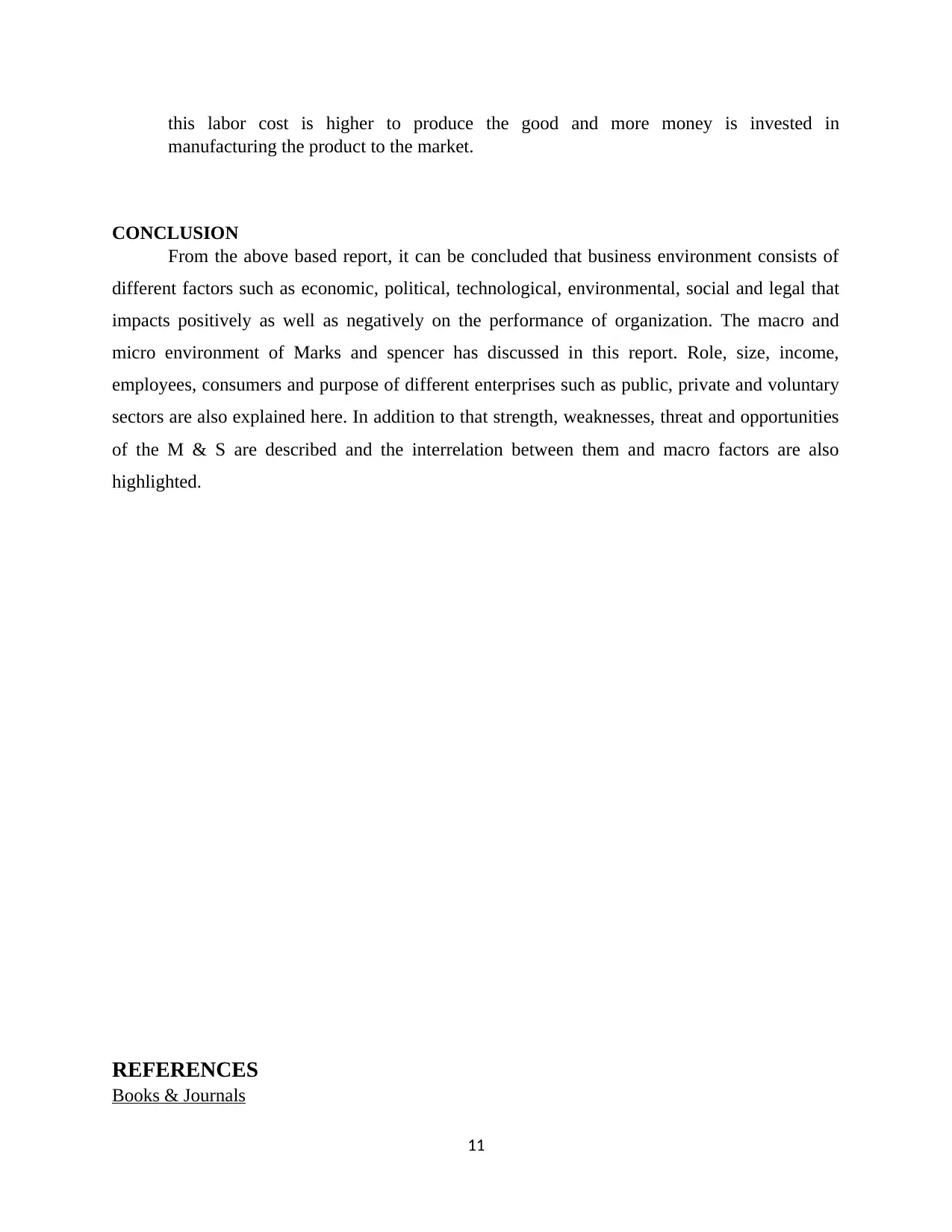
this labor cost is higher to produce the good and more money is invested in
manufacturing the product to the market.
CONCLUSION
From the above based report, it can be concluded that business environment consists of
different factors such as economic, political, technological, environmental, social and legal that
impacts positively as well as negatively on the performance of organization. The macro and
micro environment of Marks and spencer has discussed in this report. Role, size, income,
employees, consumers and purpose of different enterprises such as public, private and voluntary
sectors are also explained here. In addition to that strength, weaknesses, threat and opportunities
of the M & S are described and the interrelation between them and macro factors are also
highlighted.
REFERENCES
Books & Journals
11
manufacturing the product to the market.
CONCLUSION
From the above based report, it can be concluded that business environment consists of
different factors such as economic, political, technological, environmental, social and legal that
impacts positively as well as negatively on the performance of organization. The macro and
micro environment of Marks and spencer has discussed in this report. Role, size, income,
employees, consumers and purpose of different enterprises such as public, private and voluntary
sectors are also explained here. In addition to that strength, weaknesses, threat and opportunities
of the M & S are described and the interrelation between them and macro factors are also
highlighted.
REFERENCES
Books & Journals
11
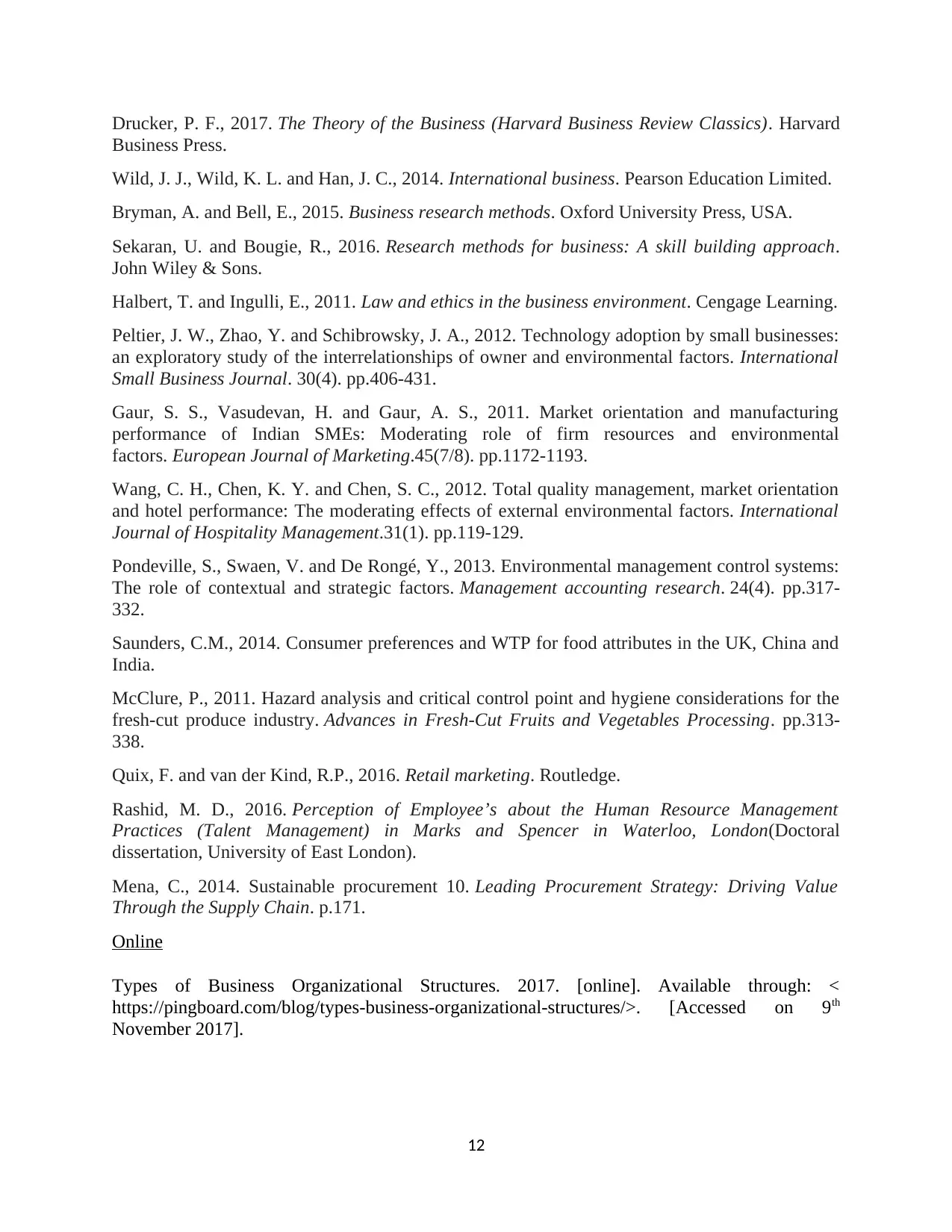
Drucker, P. F., 2017. The Theory of the Business (Harvard Business Review Classics). Harvard
Business Press.
Wild, J. J., Wild, K. L. and Han, J. C., 2014. International business. Pearson Education Limited.
Bryman, A. and Bell, E., 2015. Business research methods. Oxford University Press, USA.
Sekaran, U. and Bougie, R., 2016. Research methods for business: A skill building approach.
John Wiley & Sons.
Halbert, T. and Ingulli, E., 2011. Law and ethics in the business environment. Cengage Learning.
Peltier, J. W., Zhao, Y. and Schibrowsky, J. A., 2012. Technology adoption by small businesses:
an exploratory study of the interrelationships of owner and environmental factors. International
Small Business Journal. 30(4). pp.406-431.
Gaur, S. S., Vasudevan, H. and Gaur, A. S., 2011. Market orientation and manufacturing
performance of Indian SMEs: Moderating role of firm resources and environmental
factors. European Journal of Marketing.45(7/8). pp.1172-1193.
Wang, C. H., Chen, K. Y. and Chen, S. C., 2012. Total quality management, market orientation
and hotel performance: The moderating effects of external environmental factors. International
Journal of Hospitality Management.31(1). pp.119-129.
Pondeville, S., Swaen, V. and De Rongé, Y., 2013. Environmental management control systems:
The role of contextual and strategic factors. Management accounting research. 24(4). pp.317-
332.
Saunders, C.M., 2014. Consumer preferences and WTP for food attributes in the UK, China and
India.
McClure, P., 2011. Hazard analysis and critical control point and hygiene considerations for the
fresh-cut produce industry. Advances in Fresh-Cut Fruits and Vegetables Processing. pp.313-
338.
Quix, F. and van der Kind, R.P., 2016. Retail marketing. Routledge.
Rashid, M. D., 2016. Perception of Employee’s about the Human Resource Management
Practices (Talent Management) in Marks and Spencer in Waterloo, London(Doctoral
dissertation, University of East London).
Mena, C., 2014. Sustainable procurement 10. Leading Procurement Strategy: Driving Value
Through the Supply Chain. p.171.
Online
Types of Business Organizational Structures. 2017. [online]. Available through: <
https://pingboard.com/blog/types-business-organizational-structures/>. [Accessed on 9th
November 2017].
12
Business Press.
Wild, J. J., Wild, K. L. and Han, J. C., 2014. International business. Pearson Education Limited.
Bryman, A. and Bell, E., 2015. Business research methods. Oxford University Press, USA.
Sekaran, U. and Bougie, R., 2016. Research methods for business: A skill building approach.
John Wiley & Sons.
Halbert, T. and Ingulli, E., 2011. Law and ethics in the business environment. Cengage Learning.
Peltier, J. W., Zhao, Y. and Schibrowsky, J. A., 2012. Technology adoption by small businesses:
an exploratory study of the interrelationships of owner and environmental factors. International
Small Business Journal. 30(4). pp.406-431.
Gaur, S. S., Vasudevan, H. and Gaur, A. S., 2011. Market orientation and manufacturing
performance of Indian SMEs: Moderating role of firm resources and environmental
factors. European Journal of Marketing.45(7/8). pp.1172-1193.
Wang, C. H., Chen, K. Y. and Chen, S. C., 2012. Total quality management, market orientation
and hotel performance: The moderating effects of external environmental factors. International
Journal of Hospitality Management.31(1). pp.119-129.
Pondeville, S., Swaen, V. and De Rongé, Y., 2013. Environmental management control systems:
The role of contextual and strategic factors. Management accounting research. 24(4). pp.317-
332.
Saunders, C.M., 2014. Consumer preferences and WTP for food attributes in the UK, China and
India.
McClure, P., 2011. Hazard analysis and critical control point and hygiene considerations for the
fresh-cut produce industry. Advances in Fresh-Cut Fruits and Vegetables Processing. pp.313-
338.
Quix, F. and van der Kind, R.P., 2016. Retail marketing. Routledge.
Rashid, M. D., 2016. Perception of Employee’s about the Human Resource Management
Practices (Talent Management) in Marks and Spencer in Waterloo, London(Doctoral
dissertation, University of East London).
Mena, C., 2014. Sustainable procurement 10. Leading Procurement Strategy: Driving Value
Through the Supply Chain. p.171.
Online
Types of Business Organizational Structures. 2017. [online]. Available through: <
https://pingboard.com/blog/types-business-organizational-structures/>. [Accessed on 9th
November 2017].
12
⊘ This is a preview!⊘
Do you want full access?
Subscribe today to unlock all pages.

Trusted by 1+ million students worldwide
1 out of 12
Related Documents
Your All-in-One AI-Powered Toolkit for Academic Success.
+13062052269
info@desklib.com
Available 24*7 on WhatsApp / Email
![[object Object]](/_next/static/media/star-bottom.7253800d.svg)
Unlock your academic potential
Copyright © 2020–2025 A2Z Services. All Rights Reserved. Developed and managed by ZUCOL.





